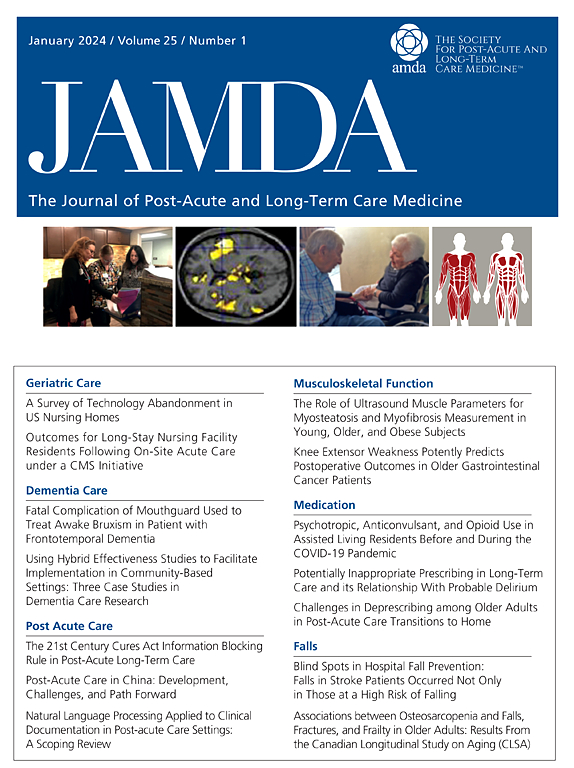日本开始长期护理的老年人亚型:潜在类分析的应用
IF 4.2
2区 医学
Q2 GERIATRICS & GERONTOLOGY
Journal of the American Medical Directors Association
Pub Date : 2025-05-03
DOI:10.1016/j.jamda.2025.105589
引用次数: 0
摘要
需要长期护理(LTC)的老年人在身体和认知功能方面表现出异质性;然而,缺乏一个既定的分类。我们的目的是确定具有LTC需求的老年人的不同亚组,并检查其预后的差异。设计回顾性队列研究。背景和参与者使用日本A市护理需求认证(与LTC和医疗索赔相关)的调查数据,我们确定了≥65岁开始LTC的社区居住成年人。来自B市的数据被用来检验聚类的有效性。方法采用潜类分析方法,根据标准化护理需求证明调查中的74项(身体功能/床上活动能力20项,日常生活活动能力12项,工具性生活活动能力6项,认知功能9项,行为问题15项,医疗程序12项)对A市的参与者进行分组。然后,我们使用回归模型检查了确定的亚型与4种结局之间的关系,包括死亡、住院、入住LTC设施和护理需求水平恶化。结果A市3841名参与者(中位年龄:83岁;(59.3%)女性),鉴定出5种亚型:(1)轻度生理型,(2)轻度认知型,(3)中度生理型,(4)中度多组分型,(5)重度多组分型。b市对聚类结果进行了验证,与轻度体质亚型相比,重度多组分亚型的死亡风险最高[校正危险比(aHR)为2.56;95%可信区间(CI), 2.02-3.24]和LTC设施的入院率(aHR, 5.91;95% ci, 4.57-7.63)。中度体质亚型患者住院风险较高(aHR, 1.32;95% CI, 1.16-1.49),中度多成分亚型更容易出现护理需要恶化(调整优势比,1.67;95% ci, 1.26-2.22)。结论和意义本研究确定了需要LTC的老年人的5个亚型。这些发现为个性化护理决策和量身定制的医疗和LTC服务计划提供了信息。本文章由计算机程序翻译,如有差异,请以英文原文为准。
Subtypes of Older Adults Starting Long-Term Care in Japan: Application of Latent Class Analysis
Objectives
Older adults requiring long-term care (LTC) exhibit heterogeneity in physical and cognitive functions; however, an established classification is lacking. We aimed to identify distinct subgroups of older adults with LTC needs and to examine differences in their prognoses.
Design
Retrospective cohort study.
Setting and Participants
Using survey data for care-need certification (linked to LTC and medical claims) in City A, Japan, we identified community-dwelling adults aged ≥65 years who started LTC. Data from City B were used to examine the validity of clustering.
Methods
We applied latent class analysis to group the participants in City A based on all 74 items [20 on body function/bed mobility, 12 on activities of daily living (ADLs), 6 on instrumental ADLs, 9 on cognitive functions, 15 on behavioral problems, and 12 on medical procedures] from the standardized care-needs certification survey. Then, we examined associations between identified subtypes and 4 outcomes, including death, hospitalization, admission to LTC facilities, and care-need level deterioration, using regression models.
Results
Among 3841 participants in City A (median age: 83 years; 59.3% female), 5 subtypes were identified: (1) mild physical, (2) mild cognitive, (3) moderate physical, (4) moderate multicomponent, and (5) severe multicomponent. The results of clustering were validated in City B. Compared with the mild physical subtype, the severe multicomponent subtype showed the highest risk of death [adjusted hazard ratio (aHR), 2.56; 95% confidence interval (CI), 2.02–3.24] and admission to LTC facilities (aHR, 5.91; 95% CI, 4.57–7.63). The moderate physical subtype showed a higher risk of hospitalization (aHR, 1.32; 95% CI, 1.16–1.49), and the moderate multicomponent subtype was more likely to experience care-need deterioration (adjusted odds ratio, 1.67; 95% CI, 1.26–2.22).
Conclusions and Implications
This study identified 5 subtypes of older adults requiring LTC. These findings inform individualized care decisions and tailored planning of medical and LTC services.
求助全文
通过发布文献求助,成功后即可免费获取论文全文。
去求助
来源期刊
CiteScore
11.10
自引率
6.60%
发文量
472
审稿时长
44 days
期刊介绍:
JAMDA, the official journal of AMDA - The Society for Post-Acute and Long-Term Care Medicine, is a leading peer-reviewed publication that offers practical information and research geared towards healthcare professionals in the post-acute and long-term care fields. It is also a valuable resource for policy-makers, organizational leaders, educators, and advocates.
The journal provides essential information for various healthcare professionals such as medical directors, attending physicians, nurses, consultant pharmacists, geriatric psychiatrists, nurse practitioners, physician assistants, physical and occupational therapists, social workers, and others involved in providing, overseeing, and promoting quality

 求助内容:
求助内容: 应助结果提醒方式:
应助结果提醒方式:


